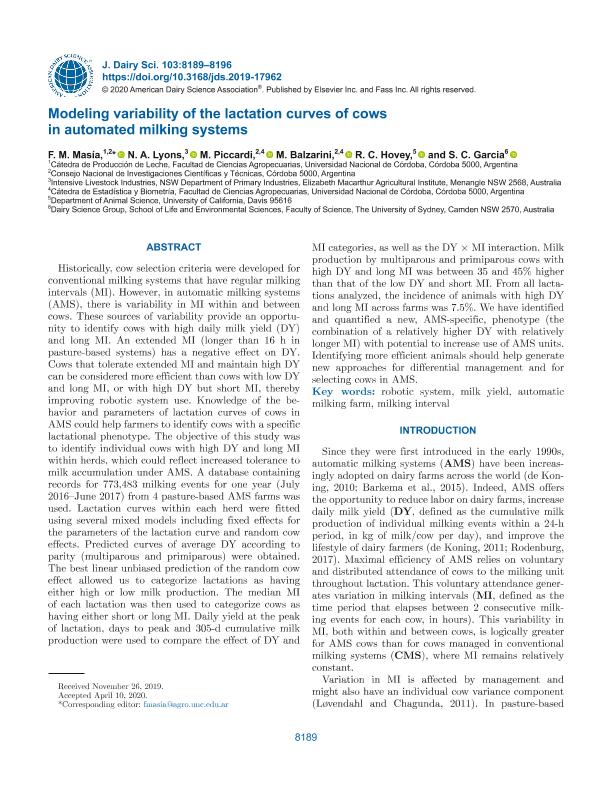Artículo
Modeling variability of the lactation curves of cows in automated milking systems
Masía, Fernando ; Lyons, N. A.; Piccardi, Mónica Belén
; Lyons, N. A.; Piccardi, Mónica Belén ; Balzarini, Monica Graciela
; Balzarini, Monica Graciela ; Hovey, R. C.; Garcia, S. C.
; Hovey, R. C.; Garcia, S. C.
 ; Lyons, N. A.; Piccardi, Mónica Belén
; Lyons, N. A.; Piccardi, Mónica Belén ; Balzarini, Monica Graciela
; Balzarini, Monica Graciela ; Hovey, R. C.; Garcia, S. C.
; Hovey, R. C.; Garcia, S. C.
Fecha de publicación:
09/2020
Editorial:
American Dairy Science Association
Revista:
Journal of Dairy Science
ISSN:
0022-0302
e-ISSN:
1529-9066
Idioma:
Inglés
Tipo de recurso:
Artículo publicado
Clasificación temática:
Resumen
Historically, cow selection criteria were developed for conventional milking systems that have regular milking intervals (MI). However, in automatic milking systems (AMS), there is variability in MI within and between cows. These sources of variability provide an opportunity to identify cows with high daily milk yield (DY) and long MI. An extended MI (longer than 16 h in pasture-based systems) has a negative effect on DY. Cows that tolerate extended MI and maintain high DY can be considered more efficient than cows with low DY and long MI, or with high DY but short MI, thereby improving robotic system use. Knowledge of the behavior and parameters of lactation curves of cows in AMS could help farmers to identify cows with a specific lactational phenotype. The objective of this study was to identify individual cows with high DY and long MI within herds, which could reflect increased tolerance to milk accumulation under AMS. A database containing records for 773,483 milking events for one year (July 2016–June 2017) from 4 pasture-based AMS farms was used. Lactation curves within each herd were fitted using several mixed models including fixed effects for the parameters of the lactation curve and random cow effects. Predicted curves of average DY according to parity (multiparous and primiparous) were obtained. The best linear unbiased prediction of the random cow effect allowed us to categorize lactations as having either high or low milk production. The median MI of each lactation was then used to categorize cows as having either short or long MI. Daily yield at the peak of lactation, days to peak and 305-d cumulative milk production were used to compare the effect of DY and MI categories, as well as the DY × MI interaction. Milk production by multiparous and primiparous cows with high DY and long MI was between 35 and 45% higher than that of the low DY and short MI. From all lactations analyzed, the incidence of animals with high DY and long MI across farms was 7.5%. We have identified and quantified a new, AMS-specific, phenotype (the combination of a relatively higher DY with relatively longer MI) with potential to increase use of AMS units. Identifying more efficient animals should help generate new approaches for differential management and for selecting cows in AMS.
Palabras clave:
AUTOMATIC MILKING FARM
,
MILK YIELD
,
MILKING INTERVAL
,
ROBOTIC SYSTEM
Archivos asociados
Licencia
Identificadores
Colecciones
Articulos(CCT - CORDOBA)
Articulos de CTRO.CIENTIFICO TECNOL.CONICET - CORDOBA
Articulos de CTRO.CIENTIFICO TECNOL.CONICET - CORDOBA
Citación
Masía, Fernando; Lyons, N. A.; Piccardi, Mónica Belén; Balzarini, Monica Graciela; Hovey, R. C.; et al.; Modeling variability of the lactation curves of cows in automated milking systems; American Dairy Science Association; Journal of Dairy Science; 103; 9; 9-2020; 8189-8196
Compartir
Altmétricas



